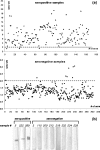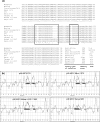Optimization and validation of recombinant serological tests for African Swine Fever diagnosis based on detection of the p30 protein produced in Trichoplusia ni larvae
- PMID: 16954235
- PMCID: PMC1594705
- DOI: 10.1128/JCM.00406-06
Optimization and validation of recombinant serological tests for African Swine Fever diagnosis based on detection of the p30 protein produced in Trichoplusia ni larvae
Abstract
We describe the validation of an enzyme-linked immunosorbent assay (ELISA) and confirmatory immunoblotting assays based on a recombinant p30 protein (p30r) produced in insect larvae using a baculovirus vector. Such validation included the following: (i) the scaling up and standardization of p30r production and the associated immunoassays, (ii) a broad immunological analysis using a large number of samples (a total of 672) from Spain and different African locations, and (iii) the detection of the ASF virus (ASFV)-antibody responses at different times after experimental infection. Yields of p30r reached up to 15% of the total protein recovered from the infected larvae at 3 days postinfection. Serological analysis of samples collected in Spain revealed that the p30r-based ELISA presented similar sensitivity to and higher specificity than the conventional Office International des Epizooties-approved ASFV ELISA. Moreover, the p30r ELISA was more sensitive than the conventional ELISA test in detecting ASFV-specific antibodies in experimentally infected animals at early times postinfection. Both the recombinant and conventional ELISAs presented variable rates of sensitivity and specificity with African samples, apparently related to their geographical origin. Comparative analyses performed on the sequences, predicted structures, and antigenicities of p30 proteins from different Spanish and African isolates suggested that variability among isolates might correlate with changes in antigenicity, thus affecting detection by the p30r ELISA. Our estimations indicate that more than 40,000 ELISA determinations and 2,000 confirmatory immunoblotting tests can be performed with the p30r protein obtained from a single infected larva, making this a feasible and inexpensive strategy for production of serological tests with application in developing countries.
Figures






Similar articles
-
Serodiagnosis of African swine fever using the recombinant protein p30 expressed in insect larvae.J Virol Methods. 2000 Sep;89(1-2):129-36. doi: 10.1016/s0166-0934(00)00209-3. J Virol Methods. 2000. PMID: 10996646
-
African swine fever virus serodiagnosis: a general review with a focus on the analyses of African serum samples.Virus Res. 2013 Apr;173(1):159-67. doi: 10.1016/j.virusres.2012.10.021. Epub 2012 Nov 3. Virus Res. 2013. PMID: 23131491 Review.
-
Antigenic and immunogenic properties of a chimera of two immunodominant African swine fever virus proteins.Arch Virol. 2001;146(9):1681-91. doi: 10.1007/s007050170056. Arch Virol. 2001. PMID: 11699955
-
High level expression of the major antigenic African swine fever virus proteins p54 and p30 in baculovirus and their potential use as diagnostic reagents.J Virol Methods. 1997 Feb;64(1):27-35. doi: 10.1016/s0166-0934(96)02140-4. J Virol Methods. 1997. PMID: 9029527
-
Virological diagnosis of African swine fever--comparative study of available tests.Virus Res. 2013 Apr;173(1):150-8. doi: 10.1016/j.virusres.2012.10.022. Epub 2012 Nov 3. Virus Res. 2013. PMID: 23131492 Review.
Cited by
-
A Robust Quadruple Protein-Based Indirect ELISA for Detection of Antibodies to African Swine Fever Virus in Pigs.Microorganisms. 2023 Nov 13;11(11):2758. doi: 10.3390/microorganisms11112758. Microorganisms. 2023. PMID: 38004769 Free PMC article.
-
Head-to-head comparison of three vaccination strategies based on DNA and raw insect-derived recombinant proteins against Leishmania.PLoS One. 2012;7(12):e51181. doi: 10.1371/journal.pone.0051181. Epub 2012 Dec 7. PLoS One. 2012. PMID: 23236448 Free PMC article.
-
Development of an ELISA Method to Differentiate Animals Infected with Wild-Type African Swine Fever Viruses and Attenuated HLJ/18-7GD Vaccine Candidate.Viruses. 2022 Aug 6;14(8):1731. doi: 10.3390/v14081731. Viruses. 2022. PMID: 36016353 Free PMC article.
-
Antibody recognition of the glycoprotein g of viral haemorrhagic septicemia virus (VHSV) purified in large amounts from insect larvae.BMC Res Notes. 2011 Jun 21;4:210. doi: 10.1186/1756-0500-4-210. BMC Res Notes. 2011. PMID: 21693048 Free PMC article.
-
Rotavirus A-specific single-domain antibodies produced in baculovirus-infected insect larvae are protective in vivo.BMC Biotechnol. 2012 Sep 7;12:59. doi: 10.1186/1472-6750-12-59. BMC Biotechnol. 2012. PMID: 22953695 Free PMC article.
References
-
- Afonso, C. L., C. Alcaraz, A. Brun, M. D. Sussman, D. V. Onisk, J. M. Escribano, and D. L. Rock. 1992. Characterization of p30, a highly antigenic membrane and secreted protein of African swine fever virus. Virology 189:368-373. - PubMed
-
- Barderas, M. G., A. Wigdorovitz, F. Merelo, F. Beitia, C. Alonso, M. V. Borca, and J. M. Escribano. 2000. Serodiagnosis of African swine fever using the recombinant protein p30 expressed in insect larvae. J. Virol. Methods 89:129-136. - PubMed
-
- Dixon, L. K., J. V. Costa, J. M. Escribano, D. L. Rock, E. Vinuela, and P. J. Wilkinson. 2000. Family Asfarviridae, p. 159-165. In M. H. V. van Regenmortel, C. M. Fauquet, D. H. L. Bishop, E. B. Carstens, M. K. Estes, S. M. Lemon, J. Maniloff, M. A. Mayo, D. J. McGeoch, C. R. Pringle, and R. B. Wickner (ed.), Virus taxonomy. Seventh report of the International Committee on Taxonomy of Viruses. Academic Press, San Diego, Calif.
-
- Escribano, J. M., M. J. Pastor, and J. M. Sánchez-Vizcaíno. 1989. Antibodies to bovine serum albumin in swine sera: implications for false positive reactions in the serodiagnosis of African swine fever. Am. J. Vet. Res. 50:1118-1122. - PubMed
Publication types
MeSH terms
Substances
Grants and funding
LinkOut - more resources
Full Text Sources
Other Literature Sources

